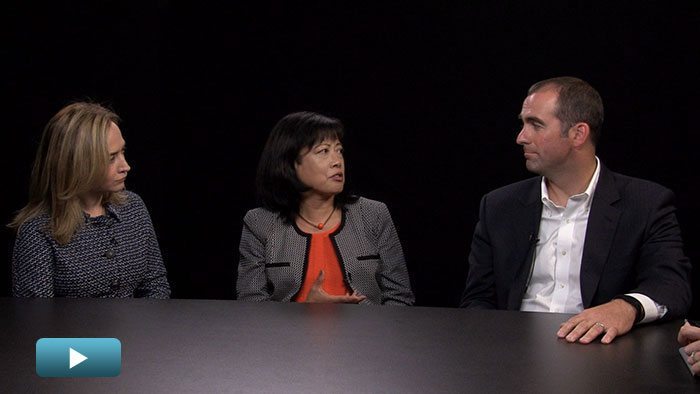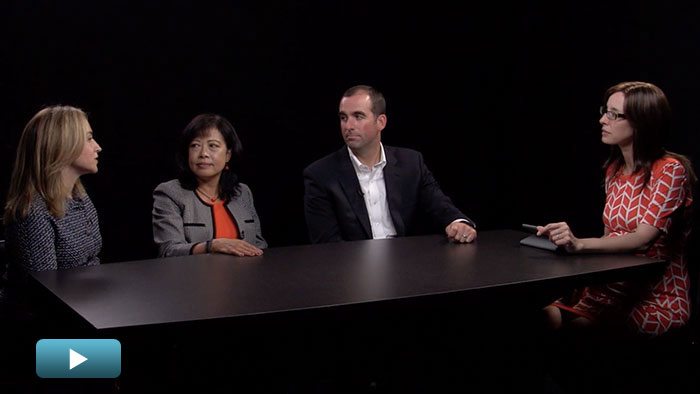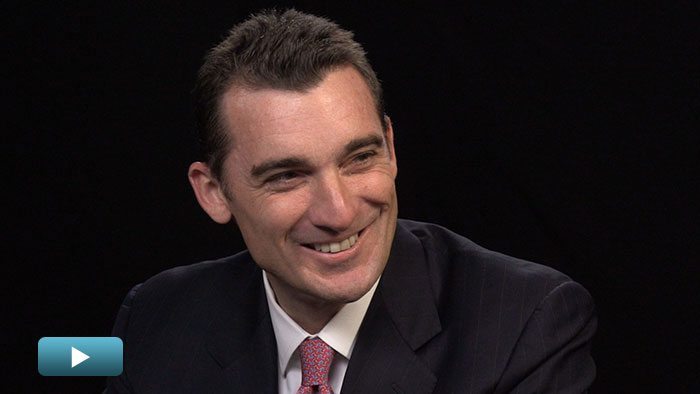Defining Core In 2015
An increasing number of investors are eyeing core and income-producing real estate. Experts from PREI, NEPC, and Connecticut State Retirement and Trust Funds discuss what core is today.
Transcript Download Transcript
Defining Core in 2015
The Evolution of Core
Zoe Hughes, PrivcapRE: I’m joined here today by Cathy Marcus, global chief operating officer for Prudential Real Estate Investors. Cherie Santos-Wuest, principle investment officer for real estate at Connecticut State Retirement and Trust Funds. And Sean Ruhmann, director of real assets research at NEPC. Thank you all so much for joining me here today.
Unison: Thank you.
Hughes: Now real estate I think has really gone back to basics in the wake of the crisis, not least thanks to an increasing number of investors really looking to put core and income producing real estate at the heart of their portfolio construction. I think some could argue that it’s actually a bit of a game changer for commercial real estate. Yet when we dig into this issue I find it really interesting that as an industry we don’t even know how to define core. You know, what does it really mean for investors? And has core actually become a little bit more risky in today’s world?
Cherie Santos-Wuest, Connecticut State Retirement and Trust Funds:
I always thought that the basis of core were five, you know, five items. The first thing is stable income, so 75 to 80 percent of the returns from real estate should be coming from income, presumably from good credit tenants. The other factor would be locational, right, geographical. Strong primary markets where there has been low volatility over cycles. The third being the quality of the asset, is it class A or at least some sort of you know, best in class and newest asset in the area, or at least newly renovated? The fourth being low leverage, 25 to 30 percent leverage. And last really you know, any combination I haven’t covered that describes less risk overall, which means a combination of markets or sector that can easily trade. Presumably if you’re an investor you would want to have an exit, and so you would want to be able to sell your asset easily, or at any point in time.
Hughes: Cathy let me up open you up to yourself first. Talk to me about what core means to you, and kind of how you know, has it changed at all?
Cathy Marcus, Prudential Real Estate Investors:
I really defined core really across our platform in much the same way as Sherry described. And you know, I wouldn’t really say that that has changed over time. What I think really changed for us post downturn or really kind of in the downturn was the need to define core. I mean there really is not an industry wide definition of core that is used in the US. And so when people say they’re a core investor or they’re investing in a core product it doesn’t mean the same thing to everyone. And when you’re running funds I think you have to take that one step further in terms of you know, if you’re going to call something a core product how much of that is you know, as people say pure core?
Hughes: And Sean, how do you actually define core? Obviously cause one of the things that I’m just wondering is are we beginning to add risk to the definition of core?
Sean Ruhmann, NEPC:
We tend to think about it as properties that are going to have high tenant demand, consistently growing rents, stable occupancies, and if you want to transact, if you want to buy or sell you could do that. And so you know, that’s kind of how we view it. That being said it is kind of a grey thing. You know, I would totally agree that one person’s core is not necessarily another person’s core.
Santos-Wuest: And I think that speaks towards how you execute your core strategy. I think there is kind of a broad brush definition of what core is and an understanding of it. But how you execute it can actually vary and it’s very interesting how very different managers execute differently.
Hughes: And Sean are you seeing that same behavioral issue but kind of perhaps you know, the definitions are kind of grey around the edges?
Ruhmann: Certainly they’re grey around the edges. You know, one of the things that I guess slightly worries us about the flood of non-US capital into US core is really just the return expectations of non-US investors versus what US investors have typically achieved out of US core. You know, if you look at yields, those prime yields that you were you know, sort of referencing in major MSAs outside of the US those are inside of what we have typically experienced here. So as an investor today you know, that could be a good thing if you have our yields converging to global yields great. You know, that means your capital values are going to go up. The concern is that’s maybe a distant, different cost of capital than the 78 percent historical returns that core and the US has generated. And does that sort of change the relative attractiveness for our clients here. You know, that’s something that we spend a lot of time thinking about.
Hughes: And I’d love to touch on the performance of core cause I think that there is one phrase that I’ve heard. It continues to surprise to the upside.
Santos-Wuest: I have been mildly surprised by the strength of our core investments. In fact you know, having plowed 750 million in addition to what we already had for core to, for us to reach our 50 to 60 percent target, and I’ll talk a little bit about why we’re a little overweight to core right now. We have reached value add type returns in 11 to almost 15 percent total returns for core with a steady 4 to 5 percent component for income obviously. And again I have to keep warning our investment committees that that is not going to continue. Please you know, lower your expectations back to the norm, to seven, you know, to the seven to nine percent current returns at some point in time in the future. And what that’s, you know, what the distance is between now and the return to the mean is still a question in my mind. I’ve seen a lot of studies, the recent BlackRock study that actually says there is still more in store for core.
Hughes: And Sean you’re obviously the consultant at the table. So give us a sense as to kind of how has performance really been? Give us a few figures, but also kind of what are your expectations as you look out?
Ruhmann: Performance has been great as you mentioned. I’m sure it has done better than most anyone would have projected going back to 2010-11-12. You know, certainly a lot of that has been decreasing yields but it’s also been just NOIs within properties has had outsized growth. So forward returns, that’s something that we think a lot about, you know, not just within real estate but how does real estate fit to other parts of our clients’ portfolios. Where we come out today is we tend to think that the returns will be slightly on the lower side of what you’d have historically got. You know, about seven to eight percent range.
But if you have cap rates that compress further and you get that strong NOI growth you could easily pencil out to high single digit, low double digit five to seven year return.
Hughes: So we could be store for even more continued strong growth?
Sean: If you don’t get cap rates expansion certainly.
Hughes: And Cathy what are you really seeing obviously you know, through the activities of PREI, what are you seeing? Have you been surprised by the amount of strong performance we’ve seen from core?
Marcus: In terms of expectations, it is hard to kind of think about the future in terms of the recent past. Cause the recent past has been so volatile, in that, in that realm from valuation perspective. In terms of growth this year and even last year and for the next couple years, we keep saying it’s just going to be all about income growth. And you’ve seen sort of six, seven, eight percent same store NOI growth across most of the core funds.
Hughes: I’d love to get a sense of how do real estate kind of compare just against some of the other asset classes in terms of the performance when we look at core, is it still a good risk adjusted return for investors?
Ruhmann: Core real estate from a portfolio context is generally very attractive. So you generally have to across other asset classes actually constrain the amount of core real estate you might want to, or real estate in general that you could have in your portfolio. So it’s certainly attractive, and you think about compressing yields that we were just talking about. You know, relative to other asset classes I mean it’s not like other asset classes are projecting outsized returns. So you’re certainly contending with that as well.
Marcus: I’ve seen recent studies that actually compare core returns in the United States against REITS and all the other asset classes realize that stocks, bonds, and it has outperformed it over 20 years. And I need to dig into the numbers to see just how valid that is. But it’s pretty compelling to see, because you know, the only asset class that has actually outperformed core has been US REITS. But the volatility in REITS as you know is so much greater. So really for the money and for the risk on a relative basis I think core is a terrific place to start.
Hughes: What is an ideal proportion of an investor’s portfolio? How much should it be given over to core?
Santos-Wuest: Ours is 60 percent, but it can, 50 percent, but it can range from 40 to 60 depending on the cycle. So we do have ranges, and 25 percent each to the other non-core value add and opportunistic sectors.
I’ve also spoken to a lot of our other co-investors, and some of them are as high as 90 percent to core or 100 percent to core. And they are over funded, so you know, frankly and we’ve had a lot of healthy discussions about this, I think it also depends on your funding level. I think if you’re 150 percent overfunded I think you can take some risks. And you should probably lower it, in our case that’s not the case for certain states. And we need to be a little bit more stable in our cash flows, so we’ve stuck to a higher percentage to core.
Hughes: Cathy let me bring you in here. Is this a time to take a little bit more risk having seen what has happened in core real estate and the performance we’ve had. Is this time to now start having incremental risk in the portfolio?
Marcus: I think it really depends as Sherry said on what’s the point of your investing? What are your objectives? Who are your constituents essentially? But in general, even if you stick to the core realm we really feel like this is a time to be taking incrementally more risk around leasing. And, that probably started last year, right that you take a little bit more risk around leasing. But where I do sort of disagree is where some people will say we think core is overpriced. We think there is potentially a market correction, so we’re going to go do some opportunistic investing. And it’s not reality that there would be some sort of correction in core but there would be no corresponding correction in an opportunistic space, in an opportunistic space you’d probably be more highly leveraged. And you probably would have a lot more aggressive assumptions around trying to achieve your underwriting.






